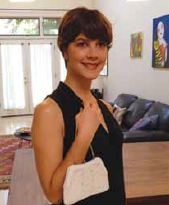Sheila Nesis didn’t think about a future as a cantor as she was growing up in Buenos Aires, Argentina. Judaism just wasn’t a big part of her family’s life. Her grandparents had some positive influence, but Sheila didn’t even attend religious school as a youngster. She was fully aware that she was part of nearly 250,000 Jews living in the country, and that her family helped to comprise the nearly 85% of that population who were Ashkenazi. Her grandparents had immigrated from Germany, Poland and France well before World War II. Some were brought over by a wealthy uncle in the textile and tailoring business. Others came during the 1880s’ wave of immigration. They knew their opportunities were limited in the old world but could see a myriad of possibilities in the new one. They established themselves in the jewelry and clothing businesses in the capital city, where the vast majority of the Jews lived, as they still do today. (In fact, Buenos Aires “boasts” of the only kosher McDonald’s outside of Israel).
Sheila’s older sister decided she wanted to become a bat mitzvah. Sheila started accompanying her sister to synagogue and immediately fell in love with the music. Not only did Sheila decide to become a bat mitzvah, too, she began substituting for the synagogue’s cantor by the time she was 16. She felt the rhythm, the cadence, the beat of the Latin countries combine with the more traditional liturgy inside her, coming out in a beautiful, meaningful and spiritual manner. “Once I entered the synagogue, I never left,” she explains. “The music felt like it was always there inside me.”
She received her training as a cantor at the Fundacion Judaica School of Shlichei Tzibur and felt blessed to have many wonderful mentors. Most of the 50 or so synagogues in Buenos Aires are Conservative, which is where she learned her liturgy and ritual. She credits the only Reform synagogue in Buenos Aires for her background in theology and philosophy. Her decision to become a cantor “just happened. It was a natural, organic decision for me,” she says. In addition to studying with learned Judaic scholars, she studied voice with the renowned voice coach and soprano, Ida Terkiel of the Teatro Colon in Buenos Aires.
The economic situation in Argentina since 2001 has led many Jews to leave the country, while others have fallen into lower economic groups. With the help of international Jewish organizations, Sheila had an opportunity to tour the United States for several years during that troubled time, giving concerts that included “liturgical Jewish music, tangos and boleros, Ladino songs, and jazz of the 1930s and ’40s.“ (Ladino is a mixture of Spanish and Hebrew, used in the Sephardic community much as Yiddish is in the Ashkenazi world.) From 2007-2012, she was the cantor at Temple Israel on Manhattan’s upper east side in New York, where she trained with Broadway voice coach Liz Caplan, voice teacher and soprano Marguerite Krull and voice coach Ruth Rainero. When her husband received an opportunity to work on a doctorate degree in media arts and computer engineering at Arizona State Univerisity, the couple moved to Phoenix in 2012. Sheila became the cantor at Congregation Kehillah in Scottsdale in July 2013. She held her first CD release party on Nov. 8 with Kehillah. The album, “Menchua,” includes six songs that exemplify her ability to combine traditional liturgy with Latin sensibilities. The album was produced by Todd Herzog, who is the cantorial soloist at Temple Solel, also in Scottsdale. It can be purchased at sheilanesis.com.






